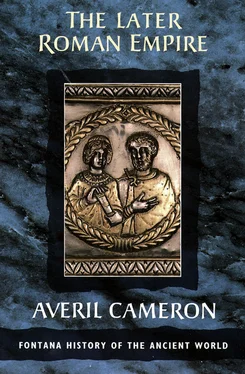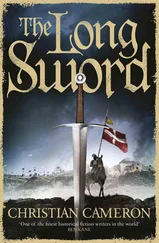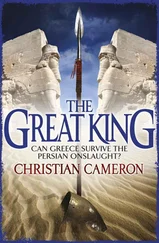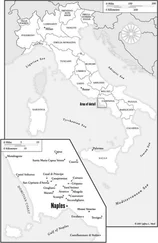For Constantine, it is a somewhat different story, for we have a number of important works by Eusebius, Bishop of Caesarea in Palestine, a great Christian writer and scholar. Eusebius established the new Christian genres of church history and chronicles, and still more important, is the major source for our understanding of Constantine. He did not suffer himself in the persecution of Christians, but knew and visited many senior clergy who did, and his later work was coloured by that experience. His Ecclesiastical or Church History , now in ten books, may have been begun before persecution broke out again in AD 303, though this is controversial; either way, it went through several rewritings as the situation literally changed all around him. The first change was when persecution was called off in AD 311, the next when Constantine defeated Maxentius in the name of Christianity at the Battle of the Milvian Bridge in AD 312; Constantine then went on to fight two further campaigns against Licinius, culminating in his victory in AD 324. The Church History received its final touches after this victory but before the Council of Nicaea which Constantine summoned in AD 325 and which Eusebius describes in his later work, the Life of Constantine ( VC, Vita Constantini ), completed after Constantine’s death in AD 337. Manuscript variants in the Church History make it clear that the author himself went over his earlier versions and touched them up in order to write out Licinius (previously presented in neutral or even favourable terms as Constantine’s ally) and defend and glorify Constantine as the champion of Christianity.
The Life of Constantine , in four books, is less a biography than an extended and extremely tendentious panegyric, whose exaggerations and distortions have led many scholars in the past to doubt whether it could be the work of Eusebius. Some still suspect that certain passages are later in date, but by detailed comparison with the techniques of Eusebius’s other writings on Constantine it has been convincingly demonstrated that the work as a whole is consistent with Eusebian authorship. Eusebius also composed official speeches for the dedication of Constantine’s church of the Holy Sepulchre in Jerusalem in AD 335, and a highly rhetorical panegyric of Constantine for the thirtieth anniversary of the emperor’s reign in AD 335–36, known as the Tricennalian Oration , or LC ( Laus Constantini, Praise of Constantine ).
There are some obvious problems about Eusebius’ reporting about Constantine. In the first place, it is extremely one-sided; he wishes to persuade us that Constantine was a model Christian emperor in everything that he did. Yet it is clear that the Life of Constantine , doubtless written with an eye to the unstable situation which followed the emperor’s death in May, AD 337, takes what Eusebius had said in his Church History much further, embellishing and adding details of a highly tendentious kind. Thus the famous story of Constantine’s vision before the Battle of the Milvian Bridge is told for the first time by Eusebius only in the Life (I.28), being entirely absent from the account in the Church History of the same battle ( HE IX.9), which is clearly in general the foundation of Eusebius’s later narrative. The theme of Constantine’s youth, and his father’s alleged sympathy for Christianity, is similarly taken further than in the earlier work, the campaign against Licinius written up as though it were a holy war, and the role played in it by Constantine’s eldest son Crispus, which is recorded in the Church History , is here entirely omitted, so as cover over the awkward fact that he had been executed at his father’s orders in AD 326. All this certainly makes one suspicious of Eusebius’s honesty as a reporter. The situation is not helped by the fact that a high proportion of what we know about Constantine is dependent on Eusebius’s Life , which (like Book X of the Church History ) includes a large number of imperial letters and edicts, either allegedly transcribed from official copies or translations of Latin originals, or summarized by Eusebius himself. In most cases there is no other evidence from which to check his accuracy, and it has been shown that the range of such material known to him was actually rather narrow; he met the emperor personally only at the Council of Nicaea in AD 325, and before that would have had limited access to documents and information from the western half of the empire, Constantine’s portion at the time. Eusebius’ is also the only eye-witness account of the Council of Nicaea, of which no official Acts survive, and is notoriously disingenuous, since he himself, as an Arian sympathizer recently formally condemned by another council, had much to explain away; he therefore glosses over the actual doctrinal issues so far as he can, and focuses instead on the unprecedented phenomenon of Constantine’s appearance as patron of the church:
he passed through the assembly like a heavenly angel, giving out a bright radiance as if by shafts of light, gleaming with fiery rays of purple, and adorned with the bright light of gold and precious stones. So much for his physical appearance. He could also be seen to be adorned in his character by fear of God and downcast eyes, his ruddy complexion, his gait and the other aspects of his appearance, including his height, which surpassed all those around him (II.10).
Eusebius’s deficiencies as a sober historian vividly illustrate however his ideological purpose as a Christian apologist, in which he was followed by many later Christian writers. His Church History , the first of its kind, was a pioneering work, taking the history of the church from the time of Jesus up to Eusebius’s own day. Though it is by no means devoid of stylistic pretensions, it differs from classical history in that it has a point to prove, and it includes verbatim documents in order to help its case. His Chronicle , surviving in Syriac and in the Latin version by Jerome, was essentially a chronological table beginning with Creation, and presenting the ancient kingdoms of the Old Testament as well as all Greek and Roman history as part of a linear progression which would eventually culminate with the Second Coming and the end of the world. Eusebius’s own linear thinking was further worked out in his apologetic works, the Praeparatio Evangelica and the Demonstratio Evangelica , which propounded the view that all previous history was in fact a preparation for the coming of Christ and the establishment of Christianity, and his Chronicle was to provide the basis for the later Christian world chronicle, which became a standard medieval historical form in both Greek and Latin. Unlike the Life of Constantine , which had a more obviously topical relevance, the Church History and the Chronicle immediately became standard; the former was translated into Latin and continued in the late fourth century by Rufinus and became a model for later church historians such as Socrates and Sozomen, both lawyers who wrote in Constantinople in the fifth century.
The audience for such works was no doubt largely if not entirely Christian; but there was also a need for historical works of a secular kind, and this may be the explanation for the series of short historical compendia in Latin which date from the middle of the fourth century and include Aurelius Victor’s De Caesaribus and the Breviarium of Eutropius. With the social and cultural changes of the third century, especially the decline of the Senate and shift of focus from Rome, senatorial history in the manner of Tacitus had apparently ceased to be written, while a Greek history of Constantine’s reign written by one Praxagoras, a pagan, has failed to survive intact. But from the end of the fourth century secular history in Greek underwent a considerable revival, which was to continue until the time of Theophylact Simocatta, writing in the seventh century; Zosimus’s New History falls into this category, though it is by no means one of the best examples. We ought also to include here the Latin Res Gestae of Ammianus Marcellinus, by far the most important historical work of the fourth century, deserving to rank with the classic writers of the republic and early empire, and a work with a vigour and power all its own.
Читать дальше












